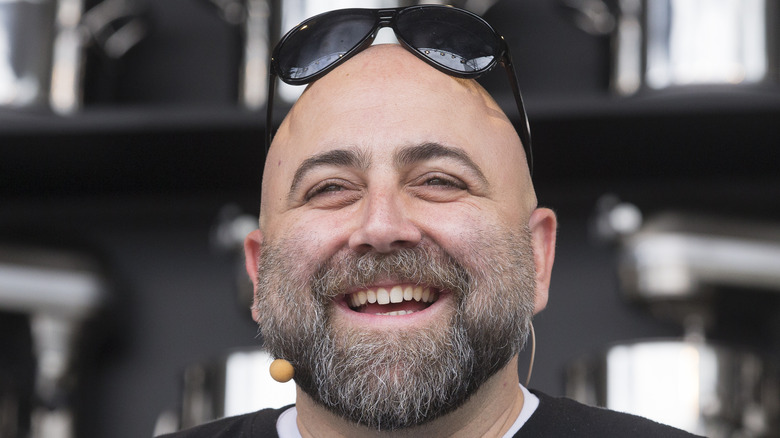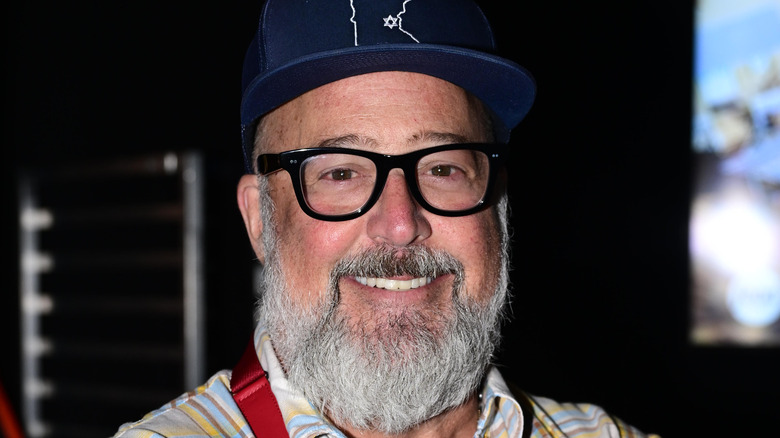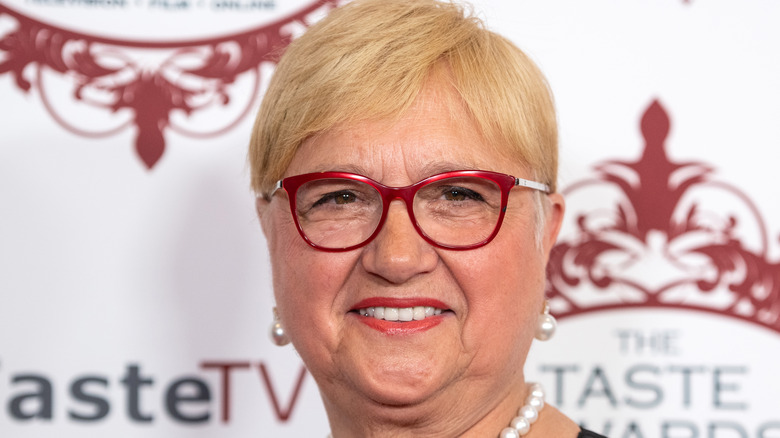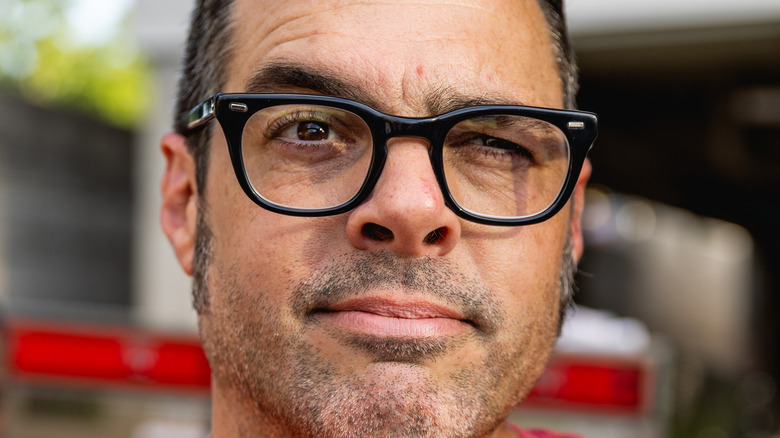The 20 Best Cooking Tips We Learned From Celebrity Chefs In 2023
At first, we invited celebrity chefs into our homes through our televisions. Then the internet came along, and we welcomed them through our computers via YouTube. Now, thanks to the power of social media, we can appeal directly to celebrity chefs for help with any (and all) cooking problems.
It's easy to see why celebrity chefs serve as a bridge between the professional kitchen and home countertops for so many people. These culinary virtuosos provide a treasure trove of insights, techniques, and inspirations with their unparalleled expertise (usually earned by toiling away for years in the world's most renowned kitchens). Through their engaging shows, easy-to-follow cookbooks, and online platforms, they're able to demystify the occasionally intimidating cooking process – making gourmet dishes accessible to the everyday kitchen enthusiast.
Given their ability to break down complex recipes into manageable steps, celebrity chefs tend to provide exceptional guidance to home cooks. With that in mind — and the end of the year fast approaching — let's take a look at some of the best cooking tips we learned from celebrity chefs in 2023.
David Chang – Don't snub the microwave
The microwave has had its ups and downs as a kitchen appliance. When it was first introduced for residential use in the late 1960s, it was seen as a savior (and it remains as such for many households). Yet the microwave's also gained a reputation as a cheap — and possibly unhealthy — fix.
David Chang disagrees with this notion, though. Chang prefers the microwave when making certain Thanksgiving sides – and doesn't feel the least bit guilty about doing so. "There's no way you're going to beat the speed of doing" mashed potatoes in the microwave, he told Tasting Table in November, or "the cleanup." So consider following the James Beard Award winner's lead, and simply zap your next batch of mashed potatoes (and gravy) in the microwave.
Ree Drummond – Prepare all your ingredients before you start cooking
Many recipes claim to take 15 minutes or so to prepare ... only to end up taking 30 to 45 minutes before you finish. In many cases, this happens because recipes don't factor in the time it takes to actually gather the ingredients and set them up.
Ree Drummond knows this pain, as well. Since "the back-and-forths to the pantry to the drawers to the fridge can really tack on time," as Drummond told Tasting Table in a November interview, "the best way to achieve the time the recipes list is to gather everything you need before you start prepping." So the next time you start a recipe that advertises its prep time, try following this cooking tip from the Pioneer Woman.
Duff Goldman – Use golden syrup in pecan pie
Golden syrup is the type of item you'd likely find at a grocery store in the United Kingdom. The sweet condiment is nearly as ubiquitous as honey in the U.K., and easy to spot on store shelves within that nation. It's a shame, frankly, that golden syrup hasn't taken off much in the U.S.
Duff Goldman seems to agree, given his tip for making pecan pie: Use golden syrup instead of corn syrup. As Goldman explained to Tasting Table in an October interview, golden syrup produces a pie that's neither "gloopy" nor "cloyingly sweet." Since American grocery stores may not stock the same items as British ones, Goldman suggests replacing "a third or maybe even a fifth of ... corn syrup" with "a little maple syrup" to achieve a similar consistency to that of golden syrup.
Marcus Samuelsson – Find ways to incorporate peanut butter
When Marcus Samuelsson uses peanut butter, he doesn't just spread it on a piece of bread and call it a day. He elevates it to heretofore unseen heights by combining it with unlikely ingredients. Samuelsson often finds ways to create new and exciting flavors by incorporating peanut butter (or simply peanuts) into unexpected dishes — and you should, too.
The peanut-inspired pop-up restaurant Samuelsson briefly opened in October offered peanut butter waffles, for instance, as well as a peanut butter and jelly old-fashioned cocktail. Now, some folks out there might think these elements have no business being together. But Samuelsson isn't one of them — and that fact alone should inspire you to use peanut butter more often in unusual culinary ways.
Jacques Pepin – Cook with seasonal ingredients
Cooking with ingredients that are in season comes with all sorts of benefits. Seasonal foods tend to be cheaper and easier to find, given they're more plentiful (if you've ever felt overwhelmed by the sight of apples while walking through the produce section in the fall, you know what we mean). Since in season items are also as fresh as they're going to get, they'll impart more flavor to your dish — which famed chef Jacques Pepin knows well.
Pepin suggested folks "cook with the season" during a September interview, believing it also makes the most economic sense to prioritize seasonal ingredients. Along those lines, Pepin added it's a good idea to use and eat any leftovers to save a few extra dollars, as well.
Alex Guarnaschelli – Fluff up frittatas with water
An egg frittata may consist mainly of scrambled eggs. But the dish is a bit more complicated to prepare than the great American breakfast food, as a frittata requires more tinkering and patience than basic scrambled eggs. To help facilitate that process, Alex Guarnaschelli suggests adding some water to fluff up those frittatas.
When Guarnaschelli discussed her new cookbook in a September interview, she stated she chooses water over cream because "scientifically, it creates the fluff factor." Somewhat surprisingly, Guarnaschelli didn't come up with this brilliant cooking tip on her own. Instead, after being served a water-infused omelet once at a restaurant, she learned it was a go-to cooking move from Dione Lucas (a culinary contemporary of Julia Child) — and decided to adopt the water-adding technique for herself.
Michael Symon – Clean as you cook with a bench scrape
No one wants to engage in a big cooking project if the kitchen is an absolute mess. But no matter how clean your kitchen is when you get started, if you don't clean at least a little bit as you go along? It's going to seem like a disaster zone sooner than later.
To that end, Michael Symon suggests using a bench scrape while you cook to help keep surfaces clear. Symon told Tasting Table during a September interview that he "literally can't cook without" a bench scrape. The kitchen tool "helps you transport things from board to pan so you're not trying to scoop things with your knife." Luckily, this vital item is also cheap, and available "online for a couple bucks" according to Symon.
Martha Stewart – Dry chicken before roasting it
Who knew the trick to prevent chicken from drying out while cooking ... is to dry it out in the fridge beforehand? Martha Stewart, apparently. Stewart revealed as much during a March interview when explaining what made the chicken at her new Las Vegas-located restaurant a success. Letting the chicken dry in the fridge overnight is "very important ... before you roast it," as it helps make the skin exceptionally crispy.
Like Stewart, you may want to combine your fridge-dried chicken with high-quality herbs and butter. But keep in mind the chicken skin is unlikely to insulate the meat as well once it's been dried, so having a meat thermometer nearby to monitor the temperature (and pull the poultry out before it overcooks) is your best bet.
Andrew Zimmern – Don't over-sauce your barbecue
We all love a good barbecue sauce. But if you decide to pour way too much of it on your ribs, what's the point of cooking them at all? You might as well skip the ribs and just guzzle the bottle of barbecue sauce on its own. Now, while some individuals may be into that serving style, Andrew Zimmern told Tasting Table in March that over-sauced barbecue is "not (his) thing" — and among the most overrated barbecue items.
Zimmern recognizes there's "a whole school of people for whom that kind of rib is great." But for those who agree with Zimmern's opinion, he suggests several underrated barbecue styles instead. This includes a pair of pig roasts: Babi Guling from Indonesia, and Lechon Cebu from the Philippines.
Lidia Bastianich – Prepare risotto with short-grain rice
Since different types of rice behave differently when cooked, selecting the right kind largely depends on the dish you're preparing. In that regard, when dealing with risotto? Lidia Bastianich recommends opting for a short-grain variety, such as arborio or carnaroli, for the best results.
As Bastianich told us in a March interview, this type of rice is ideal for risotto because it "releases the starch and makes it creamy." But she also notes this won't occur all on its own, as following the steps "of toasting, cooking, and coaxing that starch" out of the grain is crucial. The celebrity chef suggests adding hot stock a little at a time after toasting the rice, before eventually completing the process by mixing in butter and cheese.
Nadiya Hussain – Never skimp on the honey
Nadiya Hussain made a name for herself by being great at baking, so it's not surprising the Season 3 winner of "The Great British Baking Show" knows a thing or two about utilizing honey. This is exemplified by her famous honey cake containing a staggering 17 layers — which she says is easier to make than it looks.
Hussain explained during a September interview that the key is using the right honey. "As long as it's a runny honey," she told Tasting Table, "you can use whatever honey you like." She added it can be fun to infuse honey with other flavors, as well, such as orange or ginger. At home, Hussain's partial to a combination of garlic and honey, which she uses as a home health remedy rather than a cake ingredient.
Sunny Anderson – Grill with mesquite
Barbecuing with smoke that emanates from wood-based flames is a great way to add an extra layer of flavor to your meat. But that flavor doesn't simply appear in your food out of nowhere. Rather, it comes from the chemical process that occurs when wood burns, resulting in flavorful smoke that filters into your food.
As such, it's important to choose the right type of wood for this activity. Barbecue maven Sunny Anderson suggested using mesquite in a July interview – though she noted you don't have to exclusively stick with mesquite. Anderson herself is partial to cherry wood, as well, and isn't opposed to bending the rules a bit by using liquid smoke (especially when opting for a gas grill).
Aaron Franklin – Barbecue everything, not just meat
If you like barbecued meat, why stop there? After all, Aaron Franklin thinks we should go ahead and barbecue everything, including vegetables, fish, and whatever else comes to mind.
For Franklin, this is less about the food, and more about the fire used to cook it. As he told Tasting Table in June, knowing "how to utilize an entire fire, from beginning through initial combustion, through hot coals, through all the stages in the lifespan of a fire" allows you to barbecue anything. In short, Franklin believes that knowing your way around a fire, and all its levels of power, can help you cook whatever you desire on the grill — even more delicate morsels than an enormous cut of steak.
Gordon Ramsay – Let steaks rest at room temperature before cooking
When demonstrating how to cook a steak, Gordon Ramsay never seems to tire of pointing out the importance of letting the meat rest for a period of time before placing it in a hot pan. Of course, you can't just let your beef rest anywhere, as it has to be taken out of the fridge and brought to room temperature.
Ramsay explained as much in a February interview, noting a steak "needs to rest before you cook" it. Just as a steak "needs to tenderize, it needs to be seasoned, and ... rubbed either in a beautiful dry rub or lightly drizzled with a touch of olive oil" to taste its best, allowing it to warm slightly from the refrigerator's cold temperature ensures a more even cooking process. Otherwise, you risk burning the exterior of your steak before the interior is ready.
Giada De Laurentiis – Always use high quality ingredients
Using the highest quality ingredients is a must in any recipe. No matter what you're making, the dish will come out better if you prioritize the use of premium ingredients. This is especially true when dealing with Italian food. The cuisine's simplicity can instantly reveal the flavors of the original ingredients, after all — which is why Giada De Laurentiis believes using high-quality ingredients is the key to elevating home-cooked Italian dishes.
For instance, when making fresh pasta — which usually only requires water, flour, and eggs — De Laurentiis advises "investing in 00 flour," as she told us in February. According to De Laurentiis, using 00 flour instead of all-purpose flour is essential to creating great pasta from scratch. Additionally, she suggests utilizing a "big workspace" and dedicated pasta machine to make your job a whole lot easier.
Jacques Torres – Leave yourself plenty of time when making pastries
When a fan of baked goods wants a cake, they may choose to look up a recipe and make one at home. But when that same person wants a pastry, more often than not? They go in search of a bakery that knows what it's doing. Pastry-making really isn't for everyone, after all, as it can be highly technical. But if you're willing to give it some time, Jacques Torres believes that can change.
Torres suggested skipping any shortcuts in a January interview when it comes to baking pastry. He noted "there are no tricks to make (pastry) go in two minutes," as the time-consuming process includes "the caramelization of the dough in the oven, the finishing, (and) the glaze."
Daniel Boulud – Layer seasoning to promote harmony
Daniel Boulud is the chef-owner of a whopping seven restaurants — many of which are highly acclaimed. So when he says people should layer their seasoning to properly bind together the ingredients that share a plate? We should listen.
As Boulud explained during a July interview, this approach is all about creating harmony and ensuring "nothing really clashes" within a dish. Of course, while Boulud mentioned using rather inaccessible ingredients to illustrate his point — like squab with black tea powder, or freeze-dried cherries with amaranth flakes — we can still learn from the broader idea. In essence, the seasoning in your dish should be aimed at promoting a cohesive plate that allows you to "keep things in harmony" with every meal.
Richard Blais – Crack your eggs on a table
No one likes fishing out those little pieces of eggshell that sometimes get into the bowl when cracking an egg. Of course, with Richard Blais' nifty cooking tip, you may never have to do so again. Blais discussed this shell-reducing method during a February interview – a tip he originally learned from Gordon Ramsay. This simple but effective trick involves first cracking your eggs on a table (rather than a bowl), and then transferring them to the bowl.
Perhaps you thought using the bowl to crack eggs would solve a cleanliness problem — and that may be true. But that method also means accepting some potential eggshells in your bowl simply for the sake of keeping egg white off the table. While Blais acknowledged he doesn't quite understand "the mysteries of what happens with egg whites," he's confident this eggshell-reducing method works.
Carla Hall – Tear your egg whites instead of chopping them
If you've ever taken a bite of egg salad ... only to find it a bit too lumpy? You may want to look to Carla Hall for a solution to this problem. As Hall told us during an August interview, tearing up egg whites is the way to go. Unlike chopping, tearing ensures the edges don't become straight, allowing "the sauce — the mayonnaise and the egg yolks" to fill in the gaps instead.
This effect causes a "very different" mouthfeel, leading to an egg salad that's creamier and silkier. Interestingly, Hall admits she didn't come up with this tip herself. Rather, she simply used Instagram to popularize a trick she learned from Nancy Silverton on a past episode of "The Chew."
Kristen Kish – Use a good chicken broth
Since Kristen Kish loves to make chicken paprikash, she knows a few tips on how to properly prepare it. As Kish told Tasting Table in November, one of the most important steps is to "use a delicious chicken broth." This can be homemade, but it doesn't have to be; in fact, Kish gives her blessing to use a store-bought broth (one of good quality, that is).
Another trick to Kish's chicken paprikash is to "properly render the chicken thighs and bacon," which "will yield a less oily final product." Whether or not you're planning to make this particular dish, though, the concept behind Kish's cooking tip still stands. Because a quality chicken broth will elevate any recipe that requires the ingredient.




















